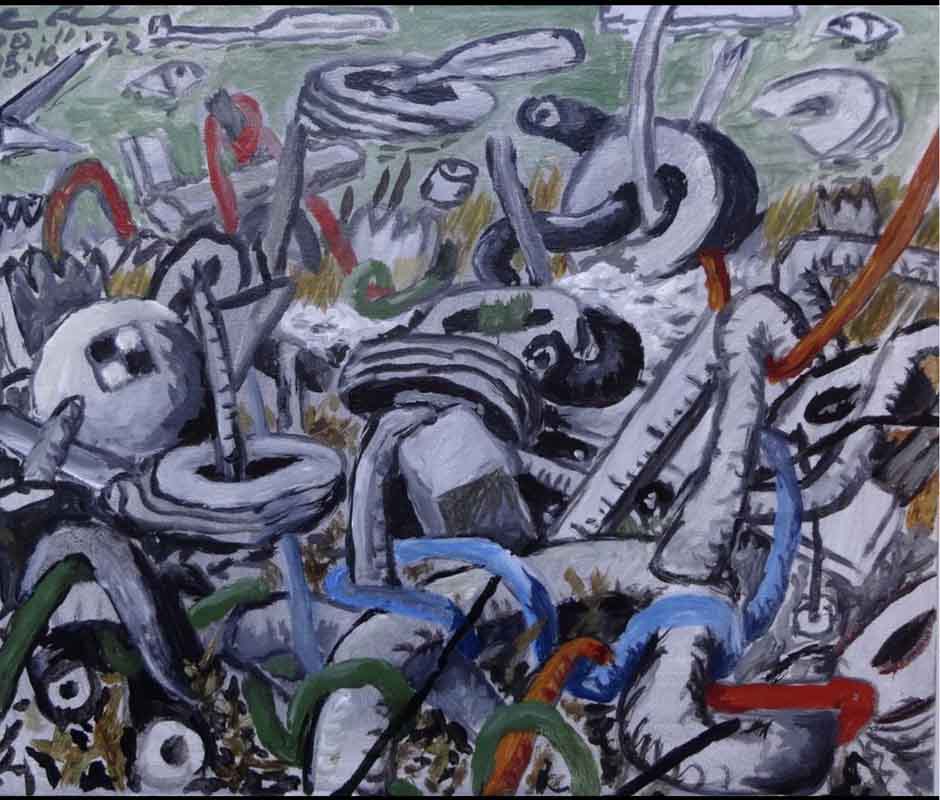Familiar with Funk Art? No? Don’t feel bad. There’s plenty of opportunity to get hip later this month at under-the-radar artist Pierre Flandreau’s retrospective show, at College of Marin.
For those curious about the movement beforehand, read on.
Although not what first comes to mind when thinking of UC Davis, a school known for its award-winning wine-making and agricultural programs, on that very same campus in the late ’50s to early ’60s, an art movement was born. Its name? Funk Art. Its nucleus? The Quonset hut, known as Temporary Building 9, or TB 9, which, in 2016 was nationally recognized for its importance in art history by being included on the National Register of Historic Places and the California Register of Historical Resources.
Key elements of Funk Art are the use and featuring of found and everyday objects; autobiographical subjects; humor, which is often inappropriate; audience engagement; and the rise of ceramics.
According to an article by Shelley Esaak on ThoughtCo, “In terms of humor and subject matter, Funk Art’s lineage goes straight back to Dada, while its aspects of collage and assemblage hearken to Pablo Picasso’s and Georges Braque’s Synthetic Cubism.”
Funk’s Davis birth began with the establishing of Davis’ department of art in 1958, with Richard L. Nelson named chair. In 1960, California-based artist Wayne Thiebaud, known for his brightly-colored depictions of everyday items like lipstick tubes, ice cream and paint cans, taught painting classes. Then in ’61, Tio Giambruni, an abstract bronze sculptor, joined the department, and more sculpture and bronze classes were added to the curriculum.
In 1962, an MFA in art practice was created, and Ruth Horsting moved from the department of home economics to teach a class titled, “The Human Figure in Sculpture.” In the fall of the same year, William T. Wiley, who won a Guggenheim Fellowship in 2004 and whose work spanned a range from film to painting to sculpture, began teaching.
The following year, Tio Giambruni completed the design and construction of a bronze foundry in TB 9, and found object and wood artist John Baxter joined the faculty. The funky stars were aligning. Pieces started being produced that clearly existed within their own genre, including artist Robert Arneson’s first life-size bust, titled Self Portrait of the Artist Losing His Marbles, and artist Bruce Nauman, then a graduate student, inserting himself physically into his work. By 1967, Funk was officially born, and the artists to come out of this time are known as Funk artists.
Funk, in other words, is a big funking deal, impacting the art world in and around Davis, including faculty at the Marin College art department in general, and teaching artists Pierre Flandreau and Chester Arnold in particular, whose work has a lot of Funk in both its overtones and undertones.
The artists met in a drawing class in 1970, and became lasting friends, both working San Francisco Chronicle paper routes in order to make time to paint.
“They created this very real Funk culture through their assiduous teaching of art students at Marin College,” said Gretchen Giles, a former journalist and publicist for Flandreau’s upcoming show.
Though Arnold has received national representation and recognition, for most of his career Flandreau has been largely uninterested in gallery representation and the business side of the art world. But he’s under the radar no longer.
Flandreau’s 50 year retrospective, “Time After Time,” tracks the evolution of Flandreau’s style, medium and content, featuring works in bronze sculpture, painting and on paper. Much of this work is brought forth from private and personal collections, tracking his unique experience of life through art. Flandreau’s portraits and still lifes shift into a series of works observing the environmental and material crises of our time, and are full of that Funk-like, satirical tone, which creates just enough humor to make the miserable truths palatable. So another funk artist emerges, and the Marin County pantheon gets ever more interesting.
‘Time After Time’ opens Nov. 7 at Fine Arts Gallery, College of Marin, 835 College Ave., Kentfield, and runs through Dec. 9. Opening reception Thursday, Nov. 10, 5-7pm. Artist talk with Chester Arnold, Wednesday, Nov. 16, 5pm. Visit www.marin.edu.












Hey Jane- What a joy to read your piece on the Time After Time show- it is an almost unbelievable achievement for Pierre to find himself receiving such attention- but I think the public and he himself will be deeply rewarded by the exhibit. Thanks for taking the time to contextualize both Pierre and me- Chester Arnold
We Need The Information
http://192.119.70.212/